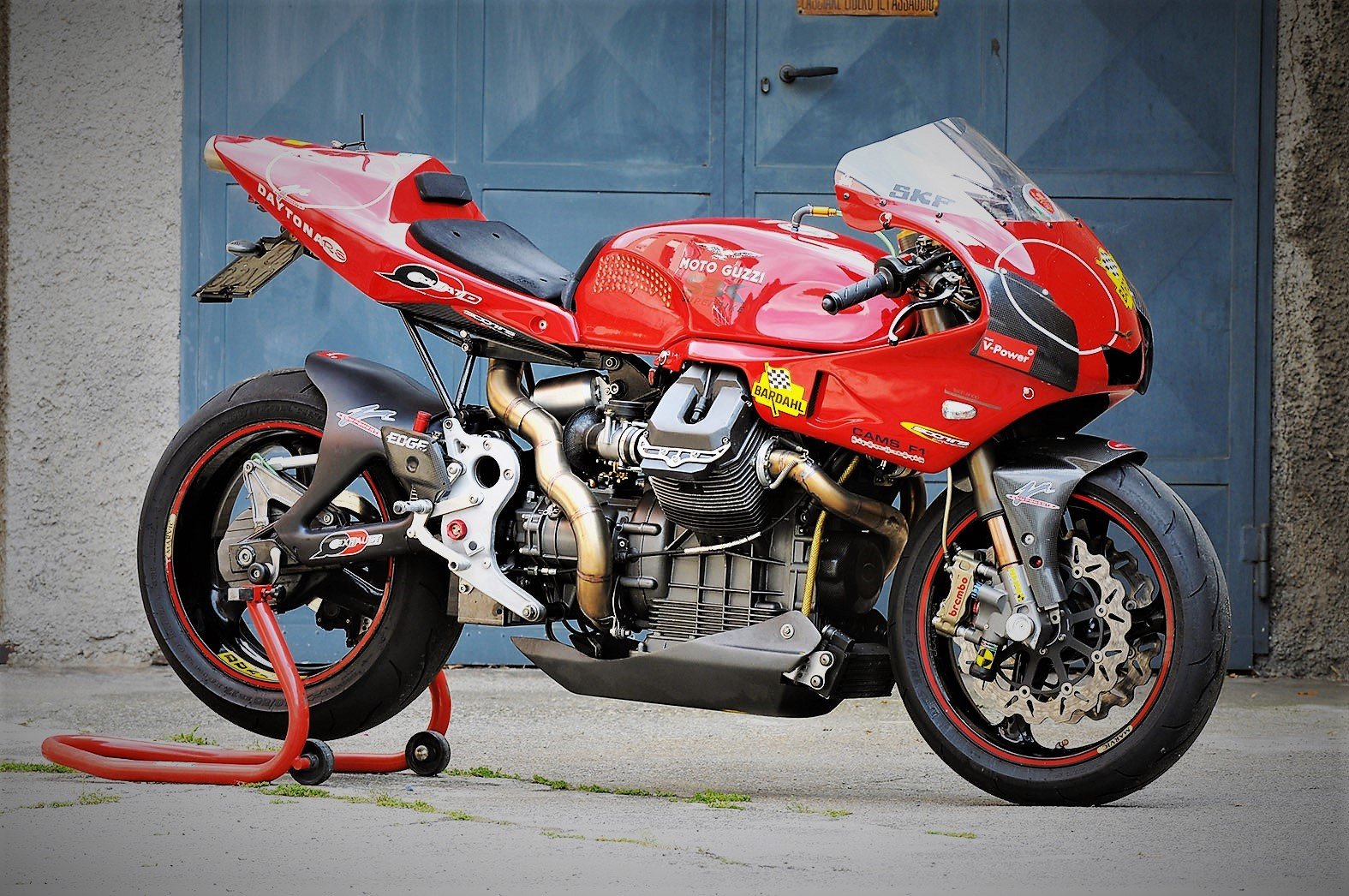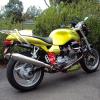-
Posts
5,449 -
Joined
-
Last visited
-
Days Won
276
Content Type
Profiles
Forums
Events
Gallery
Community Map
Everything posted by Lucky Phil
-
To set the sensor gap you clean the end of the sensor to remove any oil and apply a thin( say 1mm thick) piece of Plasticine over the entire surface then apply some grease to the surface of the Plasticine and with the original shims fitted insert the sensor and push it into place as hard as you can. Remove the sensor and remove the indented Plasticine with a thin blade and measure the thickness with a pair of vernier calipers. Adjust the shims as required leaning towards the larger end of the tolerance. Even if the little piece of Plasticine falls off it wont do any harm in the engine but if done correctly it doesnt fall off. Ciao
-
Maybe I can have a look inside with my Boroscope if I get the time. Ciao
-
Well I rode the Daytona/V11 around with the with the inlet manifold vacuum balancing adaptors uncovered and it ran fine. I forgot to install the blanking caps and didn't realise until I got back home. (it was just a few laps around the block) did't even notice. Ciao
-
Could't disagree more as a general principle. Man didn't succeed in his greatest human endeavour of landing on the moon and returning safely by shunning technology and progress. The modern motorcycle is in every way a far better piece of machinery than it was even 20 years ago. About the only thing you could question is the requirement to be a bit more technically savvy to be able to maintain them. They dont really accommodate back yard mechanics anymore. But then that's balanced out by the fact that they require far less maintenance today. Ciao
-
This I actually really like. Pity it needs a custom chassis to work. Ciao
-
I actually like the aesthetics of these on a Greenie with the caveat of the paint implications of course. Breaks up the expanse of green somewhat. My issue is from a practical point is that at 6'2" in the old money with long legs my inner thighs and knees simply dont fit in the cut outs anyway. Ciao
-
FWIW I'm a computer ludite with a windows 10 laptop and Guzzidiag has worked perfectly for me every time. True docc the TPS on diag isn't accurate enough for setting the baseline. Ciao
-
Back in the day before Ohlins made OEM forks for manufacturers the ones that came on the up spec Ducati's like 851 SP2's etc were the real deal GP forks.I had them on my 888 and they static leaked all the time. No slider damage it was what Ohlins seals used to do back then. We used to replace them with Honda Goldwing seals and they never leaked after that. In this case Chuck is right,look for slider damage and carefully remove if present. Ciao
-
I meant the jacket! Ciao
-
Here's an image I have of a Ducati 888 Corse spaghetti exhaust cross over collector and the complexity of trying to get the length and pulse timing right and a little cross talk between the cylinders. I used these images to make make my own system. Whats hidden in this image is another small diameter cross pipe behind the one in the image which connects the rear header back to the front header at another point. You can see its retaining spring at the bottom.As you can see the primary reason for the smaller cross link pipes is for negative pulse generation not to redirect exhaust gases. You're not going to get exhaust gases to turn at nearly 90 deg but it will generate a negative pulse due to the sudden change in pipe cross section. Where you locate the cross sectional change in relation to the distance from the valve is whats critical in what you want from the torque curve and any cross talk to other cylinders if possible. Ciao
-
The other cylinder? it cant really to any great extent. Ciao
-
Maybe docc you need to make Gio an offer seeing as he's selling the bike? Nice addition to the V11 story. Ciao
-
The process is that as the positive exhaust gas pressure wave travels down the primary pipe and comes to a large cross sectional change( the collector/crossover) that change creates a change in positive pulse pressure which results in a negative pressure wave back along that cylinders primary pipe to assist in evacuating the cylindes on the exhaust stroke and on the overlap to help with cylinder filling. In The case of a twin with uneven firing cylinders is difficult to get the cylinders to cross talk like a multi with a complex collector system however Ducati went some way towards that with their famous Spaghetti collector in the 80's and 90's on the 888 race bikes. The crossover in the image isn't narrow in the least. where the two headers come together there is a dramatic increase in the cross sectional ID at that point which creates the pulse. Ciao
-
largely true for the British although remember the Vincent came back post war and the Europeans were making plenty withing 25 years or so after they recovered from the war. It's hard to make judgements like this for a number of reasons primarily because of the economic dislocation after WW2 esp in Britain. Money poured into Europe to rebuild and hedge against the Russians and Communism and Britain had a war debt to pay the US. Having said all that the British motorcycle manufacturers were totally hopeless post war in just about every way, from production, to economic management. All the money went on Oak lined board rooms, Company Roll Royces and big salaries for the management instead of R&D and new machinery. Remember the Japanese didn't have any problems with construction costs producing the Honda 4 in the late 60's early 70's from a clean sheet when the British were pumping out twins whose designs dated back to the 50's and before and the Americans were making Harleys still. I've owned 3 Aprilia V twins ( all RSV1000's. 2 R's and a std RSV) and been inside them a few times including club racing bikes and they are bullet proof. If it blew up to that extent I can pretty much guarantee you it was an owner/operator issue. As for real power a Ducati Panagale makes close to 200 HP. A de-tuned one making 150 would be pretty docile for a sports tourer if they had the inclination. Ciao
-
Oh Ok docc didn't realise the Stucchi was a factory cataloged option. Ciao
-
This is where the wording is important. If it's labelled a "factory option" or Option then like docc that to me means it's an offering by the factory either fitted to the bike when ordered new or in a Guzzi option catalogue. Anything else is an accessory or an aftermarket accessory. Sometimes the semantics does lead you down the wrong path when searching for enhancements for old bikes and trying to work out if it was an OEM offering or aftermarket. Ciao
-
Not unobtainium , still available. Ciao
-
Lovely headers on my favourite car. You can see how they arrange the collectors from different banks and cylinders so they crosstalk. All depends on the firing order and what your're looking for in a torque curve as well as whether or not it uses a cross plane crank or a flat crank. Exhaust science, complicated. Ciao
-
You would need to see how it's flow path works internally docc before you could label it. I suspect it dumps into a common chamber by some convoluted means and finds it's way out via 2 outlets in an add hoc fashion. Probably doesn't matter too much anyway it's just semantics. We all understand what we mean on a Guzzi when you say "crossover" Ciao
-
Personally I use "crossover" as a generic term not a descriptive one. So there are merged crossovers, "H" crossovers etc. Then there are "collectors" of varying configurations which merge pipes but dont change their direction. Same principle and results as a cross over to produce a negative pulse wave back towards the cylinder/s. I guess the term "crossover is used when the exhaust from one bank of cylinders or cylinder can be redirected to another bank or cylinders secondary pipes, so a twin cylinder Y shaped connection isn't a crossover but a collector. Some V8 cars use a cross over after the header collectors and that fits my definition as well. Ciao
-
Did you clear any faults before trying to change the CO + engine over 60 deg C Ciao
-
There was no factory fairing for the V11 Greenie that I'm aware of. Magni has one and the belly pan you can order from Ghezzi-Brian http://www.magni.it/v11_fairing.htm Ciao
-
Try some Magnesium supplements for the cramping. You want want to prioritise working on flexibility over strengthening, dont ignore the strengthening though. As you age your range of movement naturally reduces if you dont stay supple and the you pick up silly injuries doing nothing more than extending into areas that used to be easily attainable but are now beyond you. This happens unconsciously simply doing what you used to be able to do a few years ago when more flexible. Forget comparing yourself to women they are naturally a lot more flexible than men. Some of the leg and foot issues can be from lower back disk wear and tear. A little bit of compressed disk pushing on the sciatic nerve. I cant sit reclined anymore for extended periods. I have 2 crushed vertebra in my mid back from a Phillip Island crash and a lower back with issues after 25 years of manhandling heavy jet wheels and brakes and awkward working positions under engine cowls etc. Every day is a new adventure getting out of bed:) Ciao
-
And the bike that Changed the handling standard for Japanes bikes back in the 1980's the GPZ900 Kawasaki. I owned one as well. Oh and the first Fireblade Had a 16 on it I'm pretty sure. Ciao





